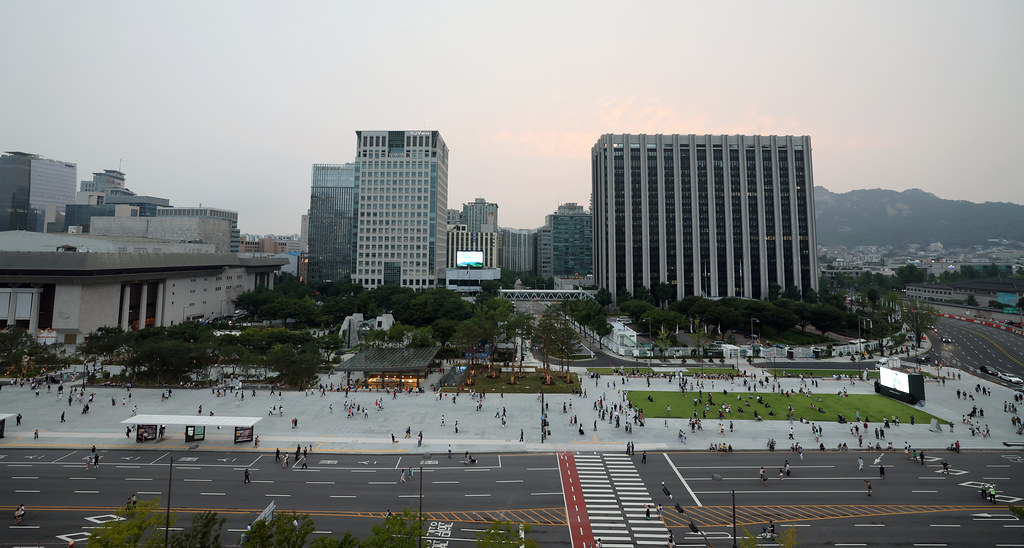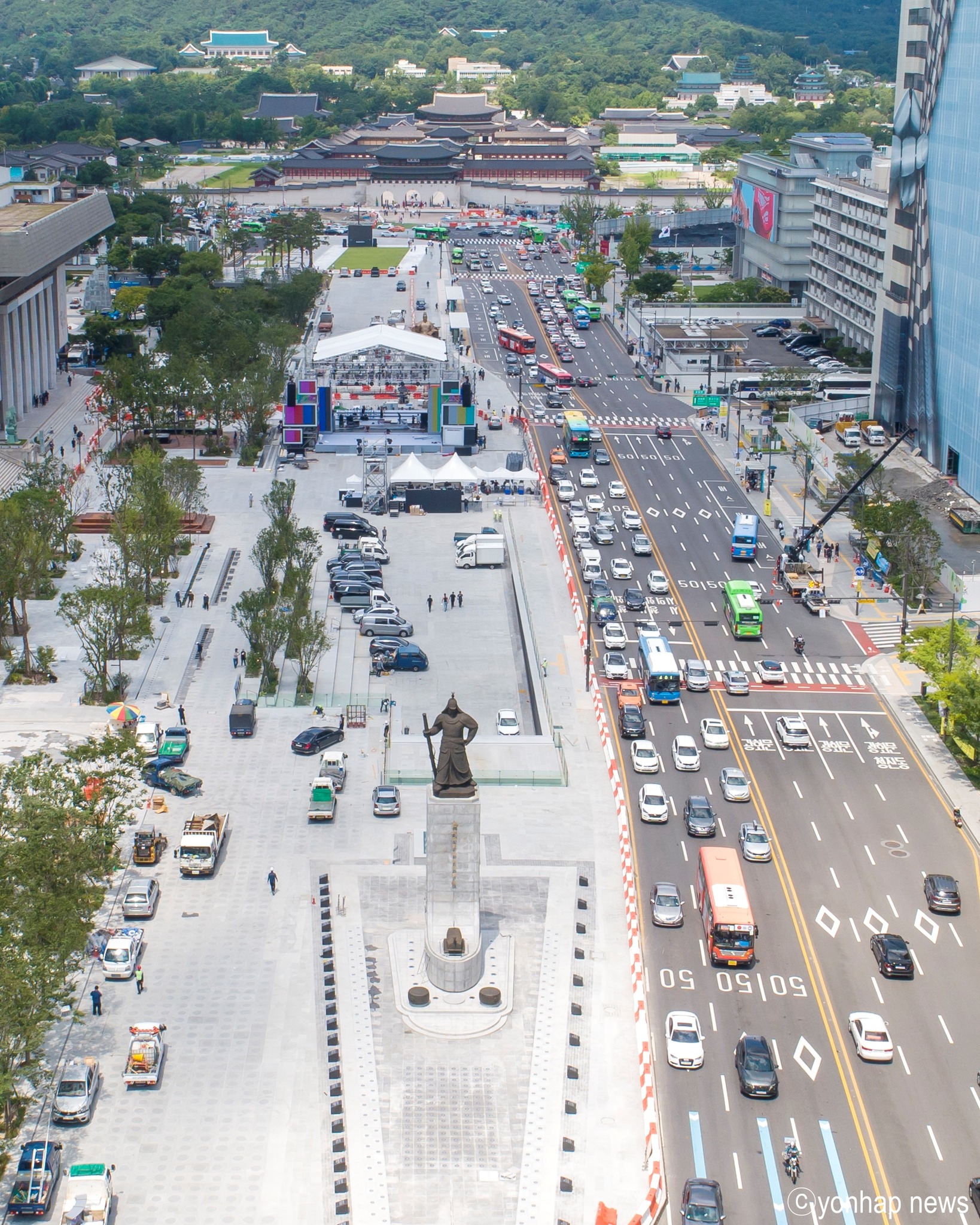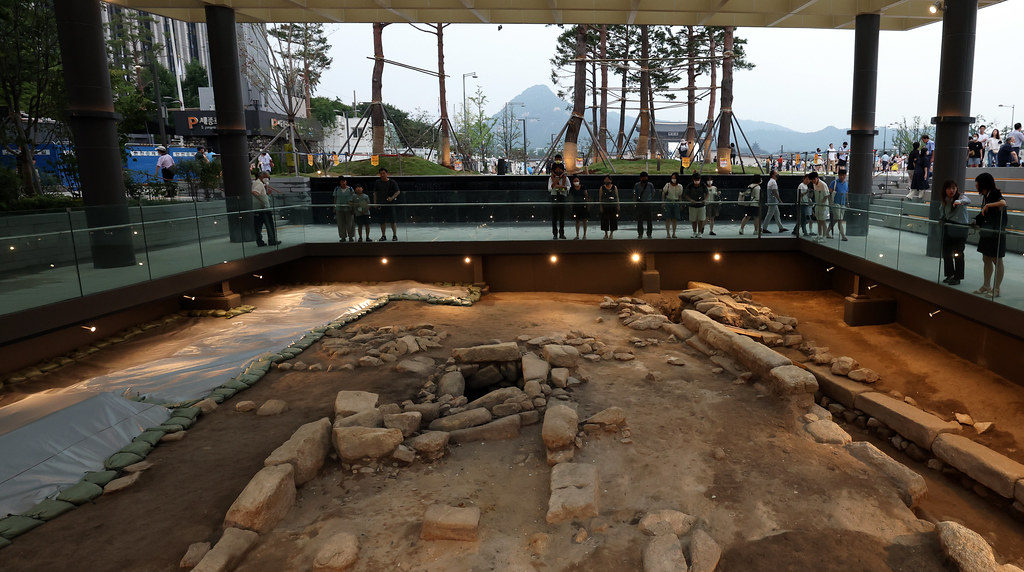
This is a wide view of Gwanghwamun Square, which was reopened to the public on Aug. 6. (Jeon Han)
By Kim Hyelin
Video = Seoul Metropolitan Government's official YouTube channel
The Seoul landmark Gwanghwamun Square on Aug. 6 was reopened to the public.
Since November 2020, the square had undergone 21 months of renovation geared to add public convenience facilities and raise pedestrian access.
The main change to the square is larger pedestrian paths. The roads west of the Sejong Center for the Performing Arts was cleared to expand the square, which now covers 40,300 square m, more than double the previous 18,840. The square is also 70% wider at 60 m, up from 35 m.

The reopened Gwanghwamun Square has more pedestrian-friendly areas and green space interspersed with venues for rest and landscaped facilities. (Yonhap News)
The square was formerly covered almost all in gray but is now a greener area with places to rest. Its 5,000 planted trees cover about a quarter of the overall green space of 9,367 square m. At the entrance are pine trees that are green year-round and trees indigenous to Korea such as oak, sansuyu (yellow cornelian cherry flower) and wild cherry.
The square has more places to rest. Visitors can sit on benches installed under the shade, and the entrance to the area near Cheonggyecheon Stream has Gwanghwamun Stairs, which utilizes differences in ground levels and slopes to create green spaces and places to rest.
The landscaped facilities throughout the plaza include a Hangeul-themed water fountain whose water streams display the 28 consonants and vowels of the Korean alphabet. Others include a 50-m tunnel water fountain made of 77 water streams and a "history water flow" with water flowing on top of the ground on which major years and events from the Joseon Dynasty (1392-1910) to the present are inscribed. In front of the statue of Admiral Yi Sun-sin (1545-98) is also a fountain.
All of these facilities form a harmony with the surrounding trees.

The well at the gate of Saheonbu, or the inspector general's office during the Joseon Dynasty, was discovered during the renovation of Gwanghwamun Square. (Jeon Han)
Visitors can also learn about Korean history. The well and drain at the gate of Saheonbu, or the inspector general's office during the Joseon era, were discovered during the renovation of the square and are now on display to preserve history.
The square stretches vertically in front of Gwanghwamun Gate, the main entry point of Gyeongbokgung Palace. The square used to be Yukjo Geori, or the Six Ministries District where several government offices were clustered as the center of politics and administration during Joseon times. It is now surrounded by buildings symbolizing Seoul.
North of the square are Cheong Wa Dae, Gyeongbokgung Palace, and the National Museum of Modern and Contemporary Art Seoul. To the west are Government Complex-Seoul, the Ministry of Foreign Affairs and Sejong Center for the Performing Arts. To the east is the National Museum of Korean Contemporary History and to the south is Seoul City Hall.
Because of so many places worth a visit nearby, foreign tourists frequented the square and the venue turned into a city landmark.
After its public opening in 2009, the square received complaints of being too narrow because of traffic on both sides and lacking in amenities. After gathering opinions on the landmark for years, the city government in 2020 began renovation of the landmark.
The Seoul Metropolitan Government on Aug. 6 at 7 p.m. held a commemorative event under the theme "Light and Harmony." Three hundred people selected through open recruitment and visitors filled the performance venue at the square, where they saw acts for 2 1/2 hours such as an orchestra, media facade shows, gugak (traditional music) and K-pop.
Seoul Mayor Oh Se-hoon said, "This is the moment when the landmark the Republic of Korea is clearly most proud of in Seoul appears," adding, "We really hope that the people of Seoul love the square much more and visit it."
A history plaza in the northern section of the square will be opened next year after the restoration of a restored woldae (traditional platform in front of buildings) and a statue of the legendary horned beast Haechi.
kimhyelin211@korea.kr